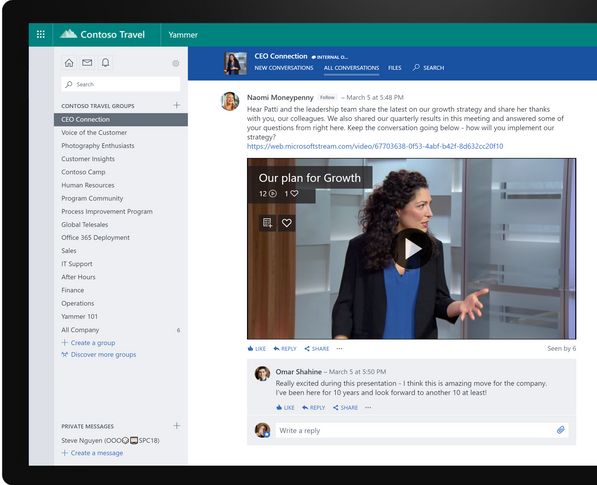This post has been republished via RSS; it originally appeared at: New blog articles in Microsoft Tech Community.
Originally published in partnership with Ragan based on a session held in-person with
Two dynamics are pressuring executives and communicators alike who wish to engage with their workforces. Companies are growing ever more global, and employee engagement has become essential for most organizations.
Leaders aren't walking the floors or their halls like they used to. Many companies are large or employees speak numerous languages. And they live and work in different locations and time zones. And many live in different parts of the world.
The good news is that technology can help connect communicators, employees and leaders, he adds. In fact, tech has become a cornerstone of today’s communications.
Social enterprise and social engagement tools such as Yammer—a part of the Office 365 suite—enable communicators, leaders and everyday employees to reach across distances and time differences to share knowledge.
Here are ways to use technology to bolster engagement within the ranks:
1. Offer employees a feedback channel.
Create a culture where it’s OK to criticize the organization or say, “We’re making a mistake, or we don’t agree with this social or this political issue,” Holste says.
Microsoft even has a community known as Curmudgeonville, where curmudgeons can grumble. Such forums can surface ideas—or make you aware of discontent before it goes public.
2. Glean ideas to drive change.
Employees are the experts in what they do every day. Management might have a different view about what someone’s job is or how it should be or what makes money, but you won’t know whether there’s a better way if you don’t ask.
Some updates to existing products or products themselves at Microsoft have come out of hackathon style threads, where people are ideating in real time where we’re capturing knowledge and harnessing knowledge. Here's an example of one of Yammer customer using Yammer as the Ideation Hub.
3. Gratitude can become a platitude.
Expressions of gratitude can become mere platitudes unless you close the loop. When you act on an employee’s good idea or follow through on matters raised on your channels, showcase that.
Highlight good work and @-mention those responsible so everyone is aware of your employees’ successes. Showcase the growth stats. Talk about that customer case or innovation that came from the factory floor. These stories help to make the Yammer value real for the rest of your company.
4. Start hosting digital live events.
Many organizations are too big and dispersed for top leaders simply to rely on raised hands at a town hall. At Microsoft, employees can pose questions on Yammer in advance, and the CEO’s team chooses the most relevant for the organization to address.
Your network can help you crowdsource topics before events. It also is useful as a back channel to communicate during events—if something goes wrong technically and they need help.
Live events in Yammer supports everything from highly produced events to quick webinars from one’s laptop. There is auto-transcription of events, can translate it into 65 different languages. This helps non-native speakers of English digest the information. Your community can also offer feedback after the event’s over, as well as those who simply don’t feel comfortable speaking up in a public forum.

5. Preserve institutional knowledge.
It’s a problem in many organizations: How do you maintain institutional knowledge when employees move on?
This could be something like accessing old customer experiences from previous conversations. Microsoft has often used Yammer to search through old customer engagements and see what happened years ago and how to reengage now.
When employees use the Question and Answer post type, it builds a knowledge base of information build on your organization IQ.

6. Train your dragons—and your leaders—to engage.
Sometimes leaders worry about wide-open discussions, Holste says. What if employees say the wrong thing? What if they ask tough questions the executives don’t want to answer publicly?
First, encourage leaders to build trust over time by following the “one-two-three rule.” Post once, reply to at least two posts, and “like” three posts. Do that regularly, whether it’s weekly or monthly, and you start to earn your co-workers’ trust.
In time, when big issues arise, you will have shown yourself willing to respond. You’ll have built the trust to say on occasion: “Hey, we’ve got to think about this. … We will get back to you on it. We just need some time to formulate how … the executive team is thinking about it.”
These two executives share insights of what they've learned about being on Yammer. And this Chief Customer Officer was interviewed about her perspective and experience with Yammer.
Need more advice or ideas? Read more from our customers, How BMO engages employees on Yammer.
What about you? What ways have you use Yammer to engage your employees?
